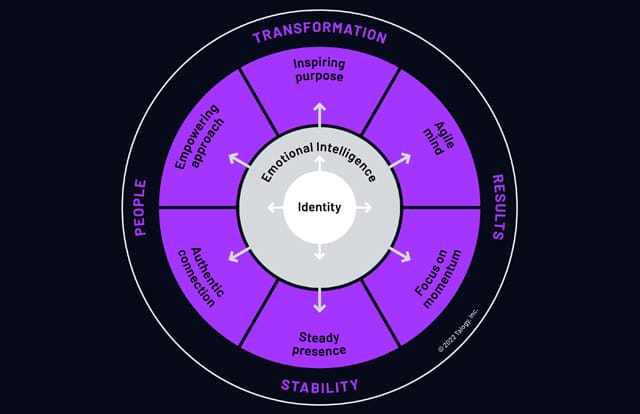Written by Cyndi Sax, Vice President, Development Solutions, and Sally Tanski, Managing Consultant
Transformational leader. Visionary leader. Servant leader. These are just a few of the defined leadership styles that exist. But the reality is that leadership isn’t a one-size-fits-all endeavour, and therefore the days of classifying leaders by only one particular style are over. To be an effective leader in today’s world, you need to tailor your approach to the person, to the situation, or to the team’s needs. That agility will allow you to best prioritise your employees and their wellbeing while achieving tangible business goals.
The traits of effective, successful leaders
The research confirms what we know intuitively: leaders have considerable impact on both business results and on how people feel about coming to work. Successful leaders recognise and proficiently manage the constant – and at times competing – demands of their organisation. Their skill lies in their ability to lean into the tensions and juggle opposing priorities.
One of our clients recently described the art of leadership as both “steering the ship and inspiring others to set sail with purpose.” Effective leaders need to maintain an awareness and a concern for people and their wellbeing while ensuring results are achieved in a demanding environment. Leadership success involves scanning the horizon to identify new opportunities and ways to transform and develop their organisation and its place in the competitive landscape while also maintaining a steady hold on the status quo to enable performance.
How to become the most successful leader you can be
Additionally, successful leaders need to understand their strengths – the leadership responsibilities that come easily and naturally to them – and also where their stretch is – the things they need to pay attention to and consciously develop. If it seems to you as if more is being demanded of leaders than ever before, you are correct. Despite the demands of the modern working world, leaders can and do achieve great success in the face of competing priorities. Here are some ways we recommend developing your leadership approach in a way that benefits both you and your team:
- Know yourself. Leaders need to know themselves in order to gracefully flex and adapt to rapidly changing circumstances. An understanding of your own leadership identity including who you are, what you stand for, and what drives you is foundational to your ability to identify and develop the skills necessary to build trust among your team and colleagues.
- Be emotionally intelligent. Emotional intelligence in leadership has been proven to be a key component of success. By being aware of feelings and managing your attitudes, you can intentionally choose behaviours that enable your personal effectiveness and enhance the quality of your relationships.
- Embrace curiosity and authenticity. Instead of thinking that you must have all the answers, learn to admit when you don’t and to ask powerful questions. Your open-mindedness, willingness to accept what you don’t know, drive to find innovative solutions, and openness to ideas that others contribute will equip you to respond genuinely and with greater agility.
- Explain the why. Leaders who are seen as being visionary and empowering are those who bring purpose to their work. Providing that background information and how employees’ work impacts the greater good is key to motivating others and demonstrating that they are part of something larger than any one person can accomplish on their own.
- Set clear, achievable goals. Pointing people in the right direction, holding them accountable, and providing feedback are multipliers of shared success. Recognise that you can’t solve every problem or deliver results by yourself, but by setting realistic goals as a team you can achieve so much more.
- Be reliable. Your ability to be a steady presence and to show empathy, consistency, and compassion will demonstrate your commitment to both people and business results.
Successful leadership is a balancing act
Dynamic, fast-paced marketplaces, challenging economic systems, flatter structures, and the drive for efficiency are all contributors to the growing need for leaders to flex their critical thinking and focus. Now more than ever, leaders need to be able to lead from both the “balcony” and the “dance floor” as described by Heifetz, Linsky, and Grashow in The Practice of Adaptive Leadership. They need to be able to move seamlessly between these different perspectives – and leadership styles – and add value to each.
But let’s not forget that leaders are human – they are going to make mistakes. It is that glimpse of imperfection that provides the perfect classroom for continuous learning. By embracing their own faults, leaders create a healthy environment for self-reflection and development.
Our InView leadership framework, derived from our own research here at Talogy, pulls together these recommendations and highlights the six attributes of successful leadership. It can serve as a compass of sorts to assist leaders with striking that coveted balance of focusing on people, transformation, stability, and results.

The days of individual leadership styles are over
It’s important for leaders to not ignore or deflect the external challenges and disruptions they and their teams face, rather to develop the inner strength and resilience to persevere and lead themselves, their teams, and their organisations through challenges. In most, if not all cases, employees value authenticity over perfection, and to achieve that means moving away from the traditional leadership style definitions and developing a balanced leadership approach.
By knowing yourself, being clear on who you are and what you stand for, and being adept at managing the complexity and often competing priorities of today’s world of work, you can skilfully lead your organisation into its future. The truth is it’s less about finding your defining leadership style and more about customising your approach to be the most effective leader and bring out the best in your team.



